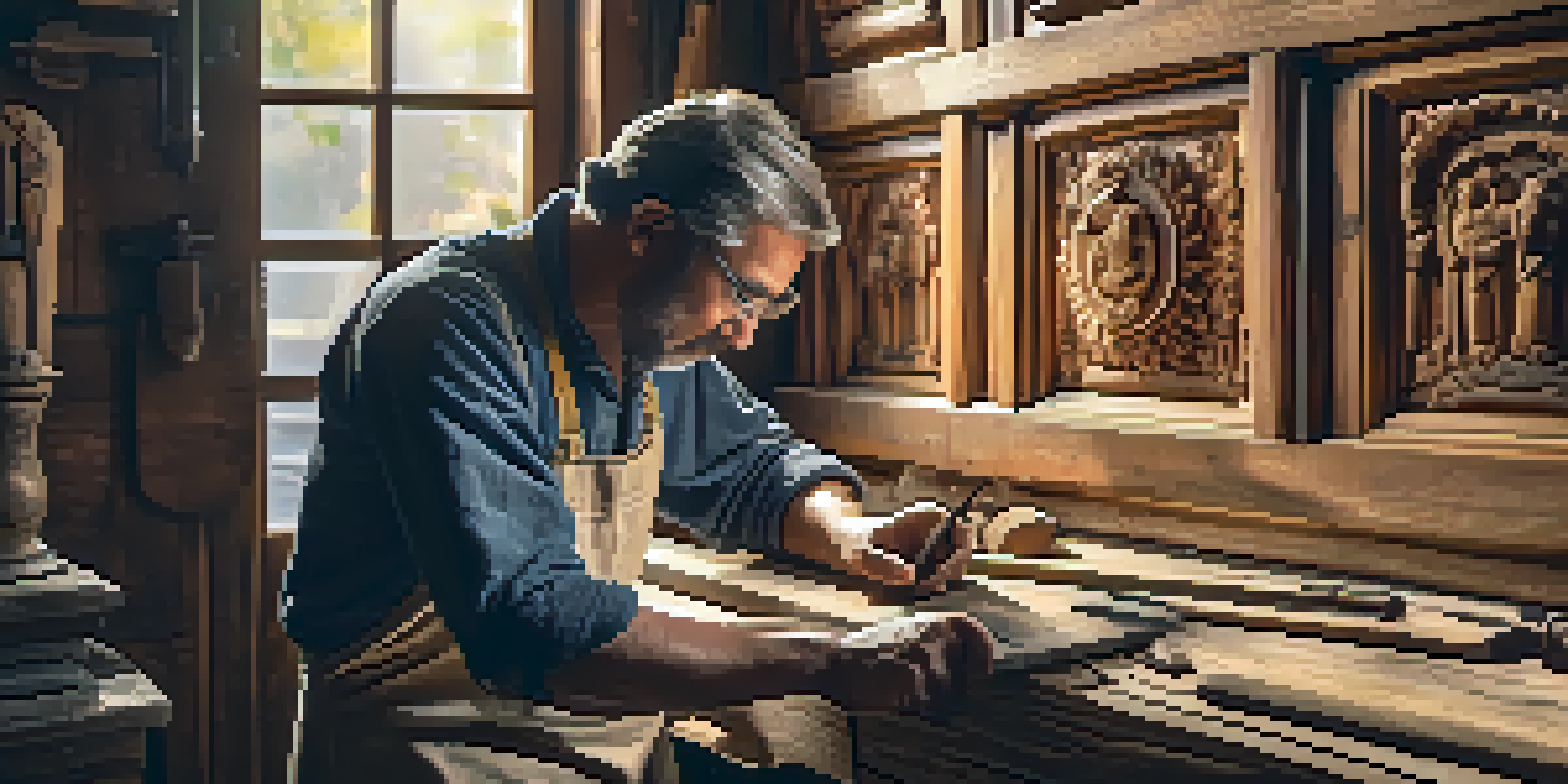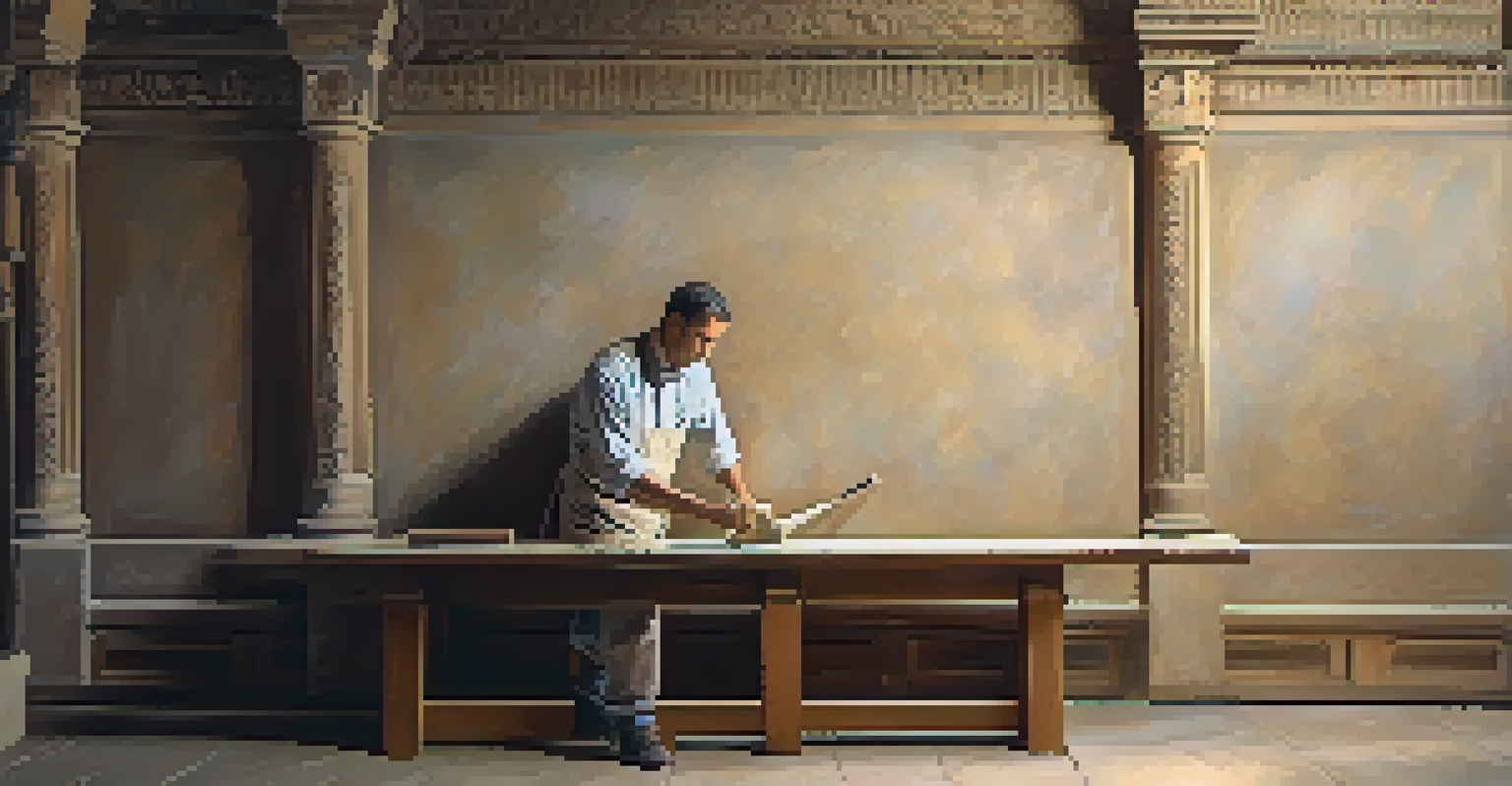The Role of Artisans in Crafting Authentic Historic Renovations

Understanding the Importance of Authenticity in Renovations
When renovating historic buildings, authenticity is key. This means preserving the character and integrity of the structure while updating it for modern use. Artisans are essential here, as they understand the traditional methods and materials needed to maintain the building's original aesthetic.
Preservation of our heritage is not a task for a few; it is a responsibility for all.
Their expertise ensures that renovations don’t just look good but also respect the historical significance of the site. For instance, using reclaimed wood or authentic plaster techniques not only enhances the beauty but also honors the craftsmanship of the era.
In a world where quick fixes are common, artisans bring a level of dedication and detail that is crucial for preserving history. Their work serves as a bridge between the past and the present, helping to keep stories alive.
The Skills Artisans Bring to Historic Renovations
Artisans possess specialized skills that are often passed down through generations. Whether it’s stone masonry, woodworking, or metalworking, these crafts require a deep understanding of techniques that may not be widely taught today. This expertise ensures that renovations are not only functional but also aesthetically aligned with the original design.

For example, a skilled carpenter might replicate intricate moldings that reflect the style of a bygone era, while a metalworker could restore ornate iron railings. Such attention to detail is what sets a renovation apart from a mere remodel.
Ultimately, the craftsmanship of artisans transforms a renovation into a true restoration. Their ability to blend old techniques with modern functionality is what keeps historic sites relevant and appreciated in today's context.
Artisans as Cultural Stewards in Historic Renovations
Artisans do more than just renovate; they act as cultural stewards of our heritage. By preserving traditional building techniques and materials, they keep history alive for future generations. This role is especially vital in a time when rapid urbanization can lead to the loss of historical identity.
The past is never dead. It's not even past.
Their work often involves research into the history of the building and the context in which it was built. For instance, understanding local architectural styles influences decisions about materials and methods, ensuring that the renovation is true to its roots.
In this way, artisans contribute to a larger narrative, helping communities connect with their past. Their dedication to craftsmanship fosters a sense of pride and ownership among residents, making historic sites more than just buildings—they become living parts of the community.
Collaboration Between Artisans and Architects
The collaboration between artisans and architects is crucial for successful historic renovations. Architects provide the vision and design, while artisans bring that vision to life through their hands-on skills. This teamwork ensures that both aesthetic and structural integrity are maintained.
During the design phase, artisans can offer insights that architects may not consider, such as the feasibility of certain traditional techniques. This exchange of knowledge leads to more informed decisions that respect both the building's history and modern standards.
Ultimately, this partnership enhances the renovation process. By blending creative ideas with practical expertise, they create spaces that honor the past while meeting the needs of today’s occupants.
Challenges Faced by Artisans in Historic Renovations
Despite their invaluable contributions, artisans face several challenges in historic renovations. One major hurdle is the availability of traditional materials, which can be scarce or costly. This shortage forces artisans to find creative solutions that respect the original design while adapting to modern needs.
Additionally, regulations and preservation guidelines can complicate renovations. Artisans must navigate these rules carefully to ensure compliance while still achieving the desired outcome. For instance, specific guidelines may dictate how much of the original structure must be preserved.
These challenges, however, are not insurmountable. Skilled artisans often relish the opportunity to problem-solve and innovate, finding new ways to blend the old with the new, which ultimately enriches the renovation process.
The Impact of Technology on Artisan Work
While traditional craftsmanship is at the heart of artisan work, technology is also making its mark on historic renovations. Tools like laser scanning and 3D modeling allow artisans to accurately assess and recreate intricate details of a building's design. This blend of old and new can enhance the precision of their work.
Moreover, technology enables artisans to document their processes and share their knowledge with a wider audience. Online platforms and social media provide a space for artisans to showcase their craftsmanship, connecting them with clients who value authenticity.
However, it’s important that technology does not replace the human touch. The artistry and intuition that come from years of experience cannot be replicated by machines. The best renovations strike a balance, utilizing technology to support rather than overshadow traditional skills.
Celebrating Artisans in the Community
Communities can play a significant role in supporting artisans who specialize in historic renovations. Events like craft fairs or workshops not only celebrate these skilled individuals but also raise awareness about the importance of preserving local history. By promoting the value of artisanal work, communities can foster a greater appreciation for their heritage.
Local governments and organizations can also contribute by providing grants or resources for artisans working on historic projects. This support can help offset the costs associated with using traditional methods and materials, making it easier for artisans to take on challenging renovations.

In turn, when artisans are celebrated and supported, the community benefits too. Historic renovations often lead to increased tourism, revitalized neighborhoods, and a stronger sense of identity, showcasing the unique character that artisans help create.